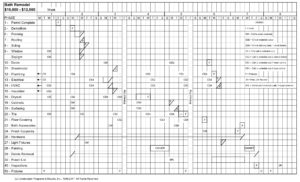It happens over and over. The job is sold, schedule is set, project gets started, and suddenly it’s behind schedule. When it happens, it eats into your profit and upsets your clients.
There are two things you can do to help keep your projects on schedule.
The first is creating a Gantt chart. Gantt charts have been around for a long time but they aren’t often used. They are easiest to create on a quadrille pad or in Excel. If you Google “Gantt chart” you’ll find sample layouts. We include a document titled “Developing a Gantt chart” in our Profitable Estimating training class.
A Gantt chart lays out exactly what needs to be done each day by the person in charge of the job. I’d create a chart for every job that takes more than a week to complete. The chart begins before the first day of the job in order to include the permitting process and the scheduling of materials that need to be ordered. The chart needs to include subs and employees as well as inspections and job cleanup. In fact, everything that needs to be done by a human to complete the job should be on the Gantt chart. There are far more details in building a project than you can keep organized and scheduled in your head.
Here’s one example of how a Gantt chart helps keep you on schedule. If you forget to call the electrician or plumber until three or four days ahead of when they’re needed, there is an excellent chance they won’t be available. Instead, arrive at an agreed start date with your sub. Then call them at least twice, preferably three times, before that day. If they are due to start their work on May 28, they should be called and reminded on May 7, 14 and 21.
You are giving your subs the courtesy of advance notice on your project, and you’re also letting them know you’re serious about your schedule. You’re aren’t going to be put off, so hopefully, they won’t try to schedule other jobs in front of yours. When you’re dependable, it’s easier for them to be dependable. Of course, this assumes you pay them weekly for their work as you should, or at a minimum of every two weeks. That keeps you near the top of their preferred list, increasing your odds of having them show up on your job when they have a choice.
Suppliers should receive the same courtesy. After you order the materials, call at least twice before the materials are due to make sure the order was placed or is in stock so it will be delivered on time. Again, paying your suppliers once a week or every other week improves your chances of getting their full cooperation.
The person running the job should look at the Gantt chart and do the things listed for that day. They don’t have to worry about yesterday or last week, nor do they need to fuss about next week. Do what’s on the chart today and the job will get done on time.
You can actually run more remodeling projects or new homes at the same time without missing anything. Line the charts up one above the other with the dates matching. Start at the top and go to the bottom doing whatever is listed on the chart for that day. Doing this minimizes things forgotten, subs or materials not showing up on time, and your own crews being spread too thin or forgotten altogether. It also slows the parade to the supply houses by those who haven’t thought ahead about what’s needed on the job.
I’ve had job forepersons or supers tell me they don’t have the time to do all that monkey motion. That’s an attitude looking for another job. It’s easier to make the time before the job starts than to deal with disgruntled clients because of a job delay. It’s easier to make the time to plan than to make the time to deal with materials that weren’t ordered and show up late for the job. Avoid the aggravation, and save the expense of expedited shipping or delivery fees.
The second thing you can do to get your jobs done on time is scheduling a pre-job conference after you sign the contract. This pre-job conference, or pre-job layout, should happen five to seven days after the contract.
The salesperson, along with the production manager, goes back to the job site and meets with the client to review the job and make sure everyone is on the same page. It’s the salesperson’s responsibility to conduct the layout. They negotiated and sold the job, so they know it inside and out. This pre-job conference is when they introduce the production department to the client, and pass the project on to production to get it built.
At the pre-job layout, you should review the contract, ask and answer questions and make sure everyone is on the same page. Subs and suppliers should be scheduled as needed to visit the job site during the layout so they can get up to speed on the job as well.
Both a Gantt chart and a pre-job layout, used correctly, will get more of your jobs finished on schedule. When that happens, you’ll make more money on the job and your clients will be happier. Isn’t that what you want?
The knowledge and experience Michael Stone gained in his 60+ years in construction has helped thousands of contractors improve their businesses and their lives. He is the author of the books Markup & Profit Revisited, Profitable Sales, and Estimating Construction Profitably, and is available for one-on-one consultations as needed.


 wpDiscuz
wpDiscuz